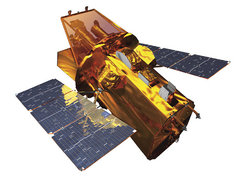A Distant Stellar Meal
Observations from Radio to Gamma rays detail how a Black Hole devoured a Star

Most galaxies, including our own, possess a central supersized black hole weighing millions of times the sun's mass. The black hole in the galaxy hosting Swift J1644+57 may be twice the mass of the four-million-solar-mass black hole lurking at the center of our own Milky Way galaxy. As a star falls toward a black hole, it is ripped apart by intense tides. The gas is corralled into an accretion disk that swirls around the black hole and becomes rapidly heated to temperatures of millions of degrees.
The innermost gas in the disk spirals toward the black hole, where rapid orbital motion magnifies its magnetic field and creates dual, oppositely directed "funnels" through which some particles may escape. Particle jets driving matter at velocities greater than 90 percent the speed of light form along the black hole's spin axis. In the case of Swift J1644+57, one of these jets happened to point straight at Earth.
"The radio emission occurs when the outgoing jet slams into the interstellar environment", explains Ashley Zauderer, leading author of the radio study. "By contrast, the X-rays arise much closer to the black hole, likely near the base of the jet."
Theoretical studies of tidally disrupted stars suggested that they would appear as flares at optical and ultraviolet energies. Thanks to the rules of relativity, the brightness and energy of a black hole's jet is greatly enhanced when viewed head-on. The phenomenon, called relativistic beaming, explains why Swift J1644+57 was seen at X-ray energies and appeared so strikingly luminous.
When first detected with NASA's Swift satellite on March 28, the flares were initially assumed to signal a gamma-ray burst, one of the nearly daily short blasts of high-energy radiation often associated with the death of a massive star and the birth of a black hole in the distant universe. But as the emission continued to brighten and flare, astronomers realized that the most plausible explanation was the tidal disruption of a sun-like star seen as beamed emission.
Two days later, on March 30, EVLA observations by Zauderer's team showed a brightening radio source centered on a faint galaxy near Swift's position for the X-ray flares. These data provided the first conclusive evidence that the galaxy, the radio source and the Swift event were linked.
The observations show that the radio-emitting region is still expanding at more than half the speed of light. Tracking this expansion backward in time could confirm that the outflow formed at the same time as the Swift X-ray source."
According to relativity, looking "down the barrel" of a particle jet also distorts time, making the jet's evolution appear to unfold many times slower than it actually is. "We expect that within two years the jet should be about 12 light-years across", says Andreas Brunthaler from the Max-Planck-Institut für Radioastronomie in Bonn, co-author of the radio paper. "Despite the galaxy's enormous distance of 3.8 billion light-years, this is large enough that the jet will be resolvable using VLBI technique." Very Large Baseline Interferometry (VLBI) combines data from widely separated radio telescopes to emulate one nearly Earth's size. For the observations of Swift 1644+57 the VLBA network in the U.S. and the 100 m Effelsberg radio telescope in Germany are jointly used as a vrtual radio telescope across the Atlantic ocean.
"Incredibly, this source is still producing X-rays and may remain bright enough for Swift to observe into next year," said David Burrows, a professor of astronomy at Penn State University, lead scientist for the mission's X-Ray Telescope (XRT) instrument team. "It behaves unlike anything we've seen before."

Two studies appearing in the Aug. 25 issue of the journal Nature provide new insights into a cosmic accident that has been streaming X-rays toward Earth since late March. That's when NASA's Swift satellite first alerted astronomers to intense and unusual high-energy flares from a new source in the constellation Draco.
Swift, launched in November 2004, is managed by NASA's Goddard Space Flight Center in Greenbelt, Md. It is operated in collaboration with Penn State, the Los Alamos National Laboratory in New Mexico, and Orbital Sciences Corp., Dulles, Va., in the U.S., along with international collaborators in the United Kingdom, Italy, Germany and Japan. MAXI is operated by the Japan Aerospace Exploration Agency as an external experiment attached to the Kibo module of the International Space Station.

